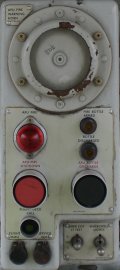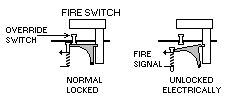Fire Protection - APU
APU Fire Protection
APU Fire Protection consists of these systems:
- APU Fire Detection.
- APU Fire Warning.
- APU Fire Extinguishing.
APU Fire Detection
There are dual fire detector loops in the APU compartment. There is no APU overheat detection.
In normal operation, both loops must sense the fire to activate the fire warning. The APU fire loops are continuously for faults. When a fault is detected in one of the loops, the systems reconfigures itself for single loop operation. When the good loop senses a fire condition, the fire warning activates. If both loops indicate a fault, a fire warning is activated.
The SYSTEM FAIL light illuminates and the EICAS advisory message FIRE/OVHT SYS displays to indicate failure of the APU fire detection system. An EICAS status message indicates the inoperative loop. The SYSTEM FAIL light and advisory message can be reset to allow monitoring of the remaining systems.
APU Fire Warning

The indications of an APU fire warning are:
- The fire bell sounds.

- The master WARNING lights illuminate.
- The APU fire warning light illuminates.
- The discrete FIRE warning light illuminates.
- The EICAS warning message APU FIRE displays.
- The APU automatically shuts down.
- The APU Fire Switch unlocks.

In addition to the above APU fire warnings, if the airplane is on the ground:
- the horn on the nose gear strut sounds intermittently (one second ON then one second OFF) and
- the Fire Warning Light on the APU Ground Control Panel illuminates.
The fire warning lights remain illuminated as long as the fire signal exists. The fire bell (and horn if the APU fire is on the ground) may be silenced by any of the following actions:
- Extinguishing the fire.
- Pushing either Master WARNING/CAUTION reset switch.
- Pulling the APU fire switch.
- Pushing the APU Ground Shutdown Switch if on the ground.
The fire warning bell rings intermittently for 2 seconds on, then 3 seconds off.
APU Fire Extinguishing
There is one APU Fire Extinguisher bottle. When the APU fire switch is pulled out:
- the APU Fuel valve is shutoff
- the APU air supply valve is closed
- the APU Generator is tripped off
- the fire extinguisher is armed
- the fire alarm bell is silenced
Rotating the switch in either direction discharges the extinguisher bottle into the APU compartment. When the bottle is discharged or has low pressure:
- The APU BTL DISCH Light illuminates
- The EICAS advisory message APU BTL displays.
APU Automatic Fire Extinguishing
An APU fire on the ground with both engines shutdown is automatically extinguished. The fire signal causes discharge of the APU fire extinguisher system a few seconds after automatic shutdown.
APU Fire and Override Switch
 The APU fire switch is mechanically locked in the down position. When a fire is detected the switch is electrically unlocked and may then be pulled out. Manual unlocking of the switch is accomplished by pushing the fire override switch located beneath the fire switch.
The APU fire switch is mechanically locked in the down position. When a fire is detected the switch is electrically unlocked and may then be pulled out. Manual unlocking of the switch is accomplished by pushing the fire override switch located beneath the fire switch.